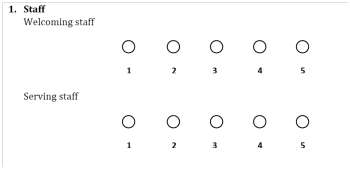TechTool
» Statics 22
» Statics 21
» Statics 20
» Statics 19
» Statics 18
» Statics 17
» Statics 16
» Statics 15
» Statics 14
» Statics 13
» Statics 12
» Statics 11
» Statics 10
» Statics 9
» Statics 8
» Statics 7
» Statics 6
» Statics 5
» Statics 4
» Statics 3
» Statics 2
» Statics 1

The World of Statistics - 2
Levels of Measurement of Statistical Variables
By Dr. Magdi Abadir, PhD
1. What is a Variable?
In statistics, a variable can be any value that is liable to change. Examples of variables are the names of employees in a firm, the wages of workers, the hourly temperature in a city in a certain day, etc. The manipulation of variables requires classifying them according to certain criteria.2. Nominal Variables
Nominal variables are those variables that have no specific numerical value. They may be numbered only for convenience. For example, the names of the employees in a firm represent a typical such case. Note that any numbering system is extremely arbitrary, and the value of the number holds no indication about its magnitude. For example, the following partial list of names is ordered alphabetically, and the item number is only written for convenience.| # | Name |
| 1 | Abraham J. |
| 2 | Abu Kassem H. |
| ... | ... |
| 74 | Zbigniew B. |
3. Ordinal Variables
In some establishments, the level of satisfaction of the customer is often assessed by filling a formulary where he (or she) is supposed to choose a number from 1 to 5, a higher score meaning better satisfaction. Below is a partial view of such a form used in a restaurant. |
Although a score of 4 would mean that the service is better than if it were 2 or 3, the numerical figures don't bear any relative meaning. For example, a score of 4 does not mean that the service is twice as good as a score of 2.
4. Interval Variables
Here, we deal with numerical variables that bear quantitative significance, like for example the temperature (o C or o F). When the temperature shifts from morning to noon from 12 to 19oC, then we can deduce that it has increased by 7 degrees. Interval variables are characterized having meaningful differences only without possessing a zero value. They include, for instance, temperature in degrees C or F, atmospheric gauge pressure ... etc.5. Ratio Variables
This category comprises all types of numerical variables having a zero datum. such as fuel prices, students, scores, workers, wages, cars, speeds, women's age (although it is not wise to deal with that particular variable!), etc.Reference
Mosteller F. (1977). "Data analysis and regression: A second course in statistics" 6th Ed., Reading, Mass.: Addison-Wesley Publishing Company.
| Dr. Magdi Fouad Abadir, Ph. D.: Dr. M. F. Abadir is currently a professor with the Chemical Engineering Department at the Faculty of Engineering, University of Cairo, Egypt. His major interests are in the fields of high temperature science and technology. During his career, he has supervised more than 110 MSc and PhD theses and published more than a hundred papers mostly in international peer review journals. He currently teaches courses in High Temperature Technology and Industrial Statistics. He is also a consultant for several industrial businesses. |



